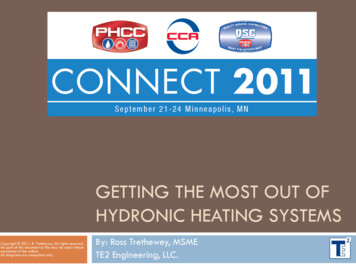
Transcription
GETTING THE MOST OUT OFHYDRONIC HEATING SYSTEMSCopyright 2011. R. Trethewey, All rights reserved.No part of this document or file may be used withoutpermission of the author.All diagrams are conceptual only.By: Ross Trethewey, MSMETE2 Engineering, LLC.
Topics 10,000 Foot ViewWhy Hydronics?Systems Approach HeatingSource Distribution System Heating Emitter
10,000 Foot View Why Are We Here? Variabilityin Fuel Costs Energy Independence Savings ReduceEmissions Comfort The Future
Why Hydronics? ComfortableQuietNo draftsEfficientEase of zoningPhysical characteristicsHeat Capacity (Btu/ft3/ F) at Room TempWater 62.4Air 0.018Water can hold 3500 times as much heat as air!Source: Modern Hydronic Heating
Hydronics Tie It All Together
Hydronic Heating Concept
Heating Source Available Sources: Boiler SolarThermal Geothermal Waste Heat And others
Heating SourceOld BoilerCondensing BoilerCondensing Boilers:1) Power VentedHeat utilized2) Modulate Gas/Air InputStandby losses3) Extract Latent HeatFlue gas losses4) Experience Corrosion
Climate72% of year in Boston isbetween 37-72 FDesign DaySource: ASHRAE
Boiler Modulation (Turn-Down) 90% of the heating season the boiler is at part-load
Condensing Boilers Only Condense When
AFUE Testing Not Considered: Short cyclingJacket & standby lossesPart-load operationOutdoor resetSetback Schedule
Outdoor Reset CurveoFBoiler watertemperature maintained195On/off controlBoiler Water Temperature176158Dew pointNatural gasDew pointFuel Oil #2135117104Boiler watertemperaturemodulated8672655032Outside Temperature14-4oF
Outdoor Reset CurveoFBoiler Water Temperature195 On/off control176158 135117104867265503214Outside Temperature-4 oFThe Goal: Lower Supply Water Temp For every 3 degrees, you gain 1% savingsHow? Efficient Building Design/Construction Better Heat Emitters (High Surface Area)
HX Material High corrosion rate environment Electrochemical Corrosion Oxygen Water Metal Galvanic Corrosion Two Dissimilar Metals Water Pit Corrosion Localized breakdown byacids, oxygen, etc. High Temp Corrosion High temps in anoxidizing environmentSource: http://www.corrosionsource.com/handbook/galv series.htm
Boiler Design Summary ModCon BoilersPick the Right Size- Manual JHigh Modulation Range- Reduce Short CyclingAFUE isn’t everything!HX Material- High grade metalHigh Surface Area HX- Scrub all the heat outControls- Outdoor Reset
Sweating is Good!
Distribution System Piping Copper, Steel, PEX, PEX-AL-PEXCirculating Pumps “It’sjust a pump” mentality In general these are not thatefficientSource: John Siegenthaler
Distribution Efficiency Distribution Efficiency Hydronic:100,000 Btu/hr design 4x Circulators (85 W each) Air (Furnace):100,000 Btu/hr design 1300 W Blower Rate of Heat Delivered (Btu/hr)Distribution Equipment Energy Use (W)100,000 Btu/hr340 W100,000 Btu/hr1300 W 295 (Btu/hr)/W 77 (Btu/hr)/WHydronic system moves the same amount of heat withalmost 4 times less electricity!
Slowing the Flow
How ECM Circs Work Standard Circulators One Speed, throttle with brakeECM Circulators Variable Speed (not a VFD) Wire to Water Efficiency of double! 50-90% energy savings
Re-Think Piping4 Single Speed Circulators vs. 1 ECM CirculatorParallel Primary LoopLow Loss Header withECM Circ and Zone ValvesOR
Pump Curves ECM Circulator with Modulation In Pressure Constant ModeImpeller slows down or speeds up tomaintain constant pressure in the systemThis means savings!Source: John Siegenthaler
Case Study- Residential Pumping
Example in ECM Pumping
Pumping Analysis Old version11 x Single Speed PSC Circs ( 85 W) 935 W Plus all the controls and relays to run each pump New version1x ECM Circulator (15-320 W) 320 W 7x Zone Valves ( 15 W) 105 W No External Communication or Wiring! On Design Day @ 0.16/kW-hr: 3.59 vs. 1.63 (55% savings)320 105 425 W
Case Study- Fort Stewart
Case Study Analysis
Distribution System Distribution EfficiencyMinimize the number of pumpsStop over pumpingSlower flow rates Higher Delta T’s Condensing boilers enjoy 35 F Delta’s T’s ECM Circulators Wire to Water Efficiency Variable FlowGood hydraulic design Low-Loss Headers, Correct Pipe Size, Mixing Valves, Etc.
Hydronic Heat Emitters Heat where you need it! Minimal Temp VariationComfortableFlexibleVariation of types
Radiant in Slab High thermal massSupply water 100 FSlower response
Radiant Above SubfloorNo PlatesLow Grade MaterialsAluminum PlatesLower Water TemperatureBetter Heat TransferFaster Response
Radiant Beneath Subfloor Retrofit applicationsMinimize floor layers Reduce R-value through floorAlways insulate joist bays!Supply water temp 140 F
Panel Radiators Low Water TemperatureHigh Surface AreaLow Water ContentFast responding19307 GallonsVery slow19603 GallonsSlow19802 GallonsSlow20090.25 GallonsFast
Panel Radiators
Zoning Without ThermostatsSource: John Siegenthaler
Fin-Tube Radiation Room Heat Load 6300 Btuh (design day) Option 1: 7 Feet of 1 Tier with 180 F Option 2: 14 Feet of 1 Tier with 130 F Option 3: 6 Feet of 3 Tier with 130 FBoiler condenses with Options 2 and 3!*Based on 65 F Entering Air Temperature
Hydro-Air High Surface Area CoilLow Water TemperatureECM Blower Air HandlerCooling and Heating
Fan Coil Sizing180 F160 FEqual Airflow140 F120 FSame BTU’s delivered
Hot Water Coil In many cases you can upsize the hot water coil todrop your water temps down 64,000 BTU/HR:SMALL HW COILSupply water 160 FReturn water 128 FLARGER HW COILSupply water 140 FReturn Water 118 FBoiler operates at 95% vs. 90%*Based on 65 F Entering Air Temperature
Heat Emitter Summary High Surface Area! Upsize radiator size or hot water coilLow Water TemperatureVarious Types RadiantIn-Slab Above/Below Subfloor Panel Radiators Fin-Tube Radiators Hydro-AirSource: John Siegenthaler
Any Questions?Contact: ross@te2engineering.com
High Surface Area Coil Low Water Temperature ECM Blower Air Handler Cooling and Heating. Fan Coil Sizing. 180 F 140 F. 120 F. Same BTU's delivered. 160 F. Equal Airflow. Hot Water Coil In many cases you can upsize the hot water coil to











